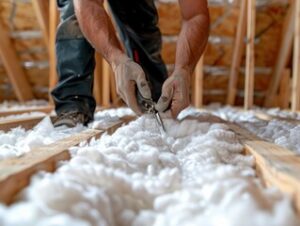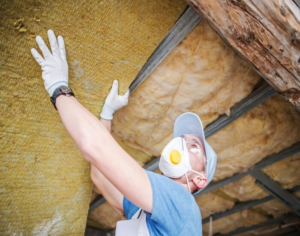Ceiling Insulation Perth improves indoor temperature regulation. This can reduce energy costs and prevent damage caused by moisture or fungi.

All types of insulation, including spray foam and cellulose, can help you achieve energy savings and a higher thermal performance across your property. However, insulating your ceiling has additional benefits.
Ceiling insulation significantly lowers your energy costs by keeping heat in during winter and out in summer, which prevents heating and cooling systems from having to work overtime. This helps reduce your carbon footprint, which is good for the environment and for your wallet.
There are several different types of insulation materials, each with its own unique properties and benefits. Some are better for reducing noise and others are more cost-effective than others. The insulation you choose will also depend on your R-Value requirement, which determines its thermal resistance. You can get an idea of the R-Value of each product by looking at its label.
Some of the most common types of ceiling insulation include fiberglass batts, cellulose, and spray foam. Fiberglass batts are a popular choice, as they are cheap and easy to install. They’re also fire retardant, eco-friendly, and contain no toxins. However, they can be itchy to handle and are less effective in moist conditions. Cellulose, on the other hand, is made from recycled paper products and treated to be fire-resistant. It is typically blown into place using a machine, and it can be used in hard-to-reach areas.
Another type of insulation is spray foam, which is available in both closed and open-cell options. Closed-cell spray foam is more dense and offers superior soundproofing. It has a high R-Value of 6 to 7 per inch and is an effective air and moisture barrier. Open-cell spray foam is more affordable and offers an average of R-Value of 3.6 to 3.9 per inch. It is resistant to mould and mildew, making it a more hygienic option than closed-cell spray foam.
It’s important to note that ceiling insulation is most effective when it’s installed correctly. Poor installation can result in decreased performance and reduced energy savings. That’s why it’s important to hire a professional, who can ensure that your insulation is properly installed and performs at its optimal level.
If you’re thinking about adding insulation to your ceiling, be sure to consult Rubcorp for a free consultation and expert guidance. Our team of highly-trained and experienced professionals will assess your needs and provide recommendations based on your home’s unique requirements. Contact us today to schedule your appointment.
Improves Indoor Comfort
Ceiling insulation is a crucial investment in the energy efficiency and indoor comfort of your home. It significantly reduces heat flow, improves thermal resistance, and enhances sound absorption. It also helps to maintain a consistent indoor temperature, saves on heating and cooling costs, and improves indoor air quality. In addition, proper insulation can help to prevent the buildup of mildew and mould.
There are many different types of ceiling insulation available, including fiberglass, cellulose, and spray foam. Fiberglass insulation is commonly available in batts, rolls, and pre-cut sections. It is an affordable option that works well in most spaces with standard spacing and minimal obstructions. Cellulose insulation is made from recycled paper products and offers excellent soundproofing properties. Spray foam insulation is a more expensive option that is applied using a spray gun and expands on application, filling up all gaps and crevices.
The effectiveness of ceiling insulation to improve indoor comfort has been demonstrated in a number of studies. The results of one such study showed that insulating the ceiling of a house reduced maximum indoor temperatures by 4 K in summer. This is a significant reduction in temperature that will result in improved comfort, especially for the elderly and people with respiratory conditions.
In addition to improving the comfort of your home, ceiling insulation can also improve the performance of your HVAC system. It can reduce the amount of energy required to keep the house warm in winter and cool in summer, which can significantly lower your electricity bills. This means that you can spend less money on your energy bills, and have more money to put towards other household expenses.
In order to get the most out of your ceiling insulation, it is important to work with a reliable company that has extensive experience and expertise in installing insulation for both new and existing homes. They can provide expert advice and guidance on the best types of insulation for your needs, as well as ensuring that it is installed correctly. This will maximise your energy efficiency, reduce your energy bills, and ensure that you have a comfortable and enjoyable home.
Reduces Energy Bills
Up to 40% of your energy costs can be wasted in uninsulated homes through air leaks around windows, doors, electrical outlets and recessed lighting. Installing insulation and ensuring proper sealing will reduce the amount of heat that escapes your home during winter and that is let in during summer. This is a great way to save on your energy bills and have more money left to invest in other home improvement projects.
Insulating your home is a smart investment that will pay for itself many times over the years, especially if you choose to upgrade to higher R-Values. Having the right R-Value for your climate zone is crucial to ensure optimal performance.
Ceiling insulation provides the perfect barrier between hot and cold areas, helping you maintain the correct internal temperature in your home throughout the year. It keeps the warm air in during winter and reflects the heat away in summer, making it a cost-effective choice for reducing your energy bills.
Choosing the right insulation for your home is a critical decision that can have long-term benefits for your family and the environment. Insulation will help reduce your energy bills and make your home more comfortable in any weather. It also helps to protect the environment by reducing harmful greenhouse gas emissions.
The R-Value of your insulation is an important factor in determining the thermal performance and how much it will save you on your energy bills. To maximize the benefits, ensure that the insulation is installed correctly to achieve the highest R-Value possible. The right thickness and density of the insulation will also impact its performance, with thicker insulation achieving a higher R-Value than thinner products.
A variety of insulation materials are available, including cellulose, fibreglass batts and spray foam. Each has its own advantages and disadvantages, with cellulose being one of the most cost-effective sustainable options for your ceiling. However, it is not moisture resistant and can sag over time, resulting in decreased R-Value. Spray foam is another option that offers excellent R-Values, but it is expensive and can be dangerous to work with.
Prevents Moisture Buildup
Insulation helps prevent moisture buildup in attics and crawl spaces. This type of moisture can damage building materials and lead to dangerous mold and mildew. Insulation can prevent the accumulation of moisture in these areas, which can help extend the lifespan of the insulation and the structure. It also prevents moisture from entering the house, which can lead to rot and wood damage.
Moisture can form when warm air meets cooler surfaces in uninsulated attics and crawl spaces. This is especially common in older homes that have poorly designed attics and crawl spaces. Insulation prevents condensation from forming and helps maintain a consistent temperature throughout the home, which prevents moisture from forming on surfaces. It also regulates humidity levels, which can be beneficial for people with allergies or asthma.
Many different types of insulation can prevent the buildup of moisture in attics and crawl spaces. For example, spray foam is an ideal solution for preventing moisture because it expands to fill gaps and create an airtight seal. It also has a long lifespan and does not sag or settle over time, which can be a problem for other insulation types. Another option is loose-fill insulation, which is blown into attics and crawl spaces using a machine. This type of insulation can be made from cellulose (which is made from recycled paper products) or fibreglass, and it provides thermal, acoustic and soundproofing benefits.
Foam board insulation is also a good choice for preventing the buildup of moisture in attics and in crawl spaces. This type of insulation consists of rigid panels that are made from materials like polystyrene or polyisocyanurate. It is lightweight and easy to handle, and it offers excellent thermal, acoustic and soundproofing properties. Foam board insulation also has a long lifespan and does not degrade or sag over time.
In addition to preventing the buildup of moisture in attics, crawl spaces and other parts of the home, ceiling insulation also blocks external pollutants that can decrease indoor air quality. For instance, dirt, radon, smoke and mold can penetrate through air gaps in improperly sealed or uninsulated areas. Insulation prevents these contaminants from easily entering the home, which can cause illnesses and discomfort for occupants.
